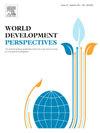Refugees’ home-making practices as assemblages: material & symbolic features of housing settlements in the camp
IF 2.3
Q2 DEVELOPMENT STUDIES
引用次数: 0
Abstract
Scholars often conceptualize the refugee camp as a humanitarian space (Agier, 2010) or space of protection (Ticktin, 2011), constructed by host governments and humanitarian agencies. However, in such framings, camp dwellers are often seen as passive recipients, isolated from any opportunity to cultivate a sense of belonging. This perception is reinforced by institutional accounts and reports that overlook refugees’ everyday spatial practices to reshape their environments, resulting in not only obscuring how refugees actively reconfigure camp spaces through home-making, but also contributing to spatial interventions that feel imposed and disconnected from lived realities, precluding avenues for belonging. This paper explores how Palestinian refugees construct the camp both spatially and temporally through everyday home-making practices that imbue the camp with meaning and attachment. To achieve this, I utilize the assemblage theory (Deleuze and Guattari, 1987, DeLanda, 2006, McFarlane, 2009, Dovey, 2010) as the analytical approach to better understand home-making as an open-ended process, analyzing the material and symbolic features of housing settlements in the camp. The study adopts a bottom-up methodology that combines empirical and archival research to investigate three Palestinian refugee camps in Jordan: Baqa’a, Al-Husn, and Talbiyeh, drawing from ethnographic fieldwork based on interviews, direct observation, and graphic journaling. This study argues that although camps are initially shaped by institutional planning, refugees’ home-making practices reshape their development over time. This dynamic interplay challenges static institutional layouts, showing how refugees’ modifications redefine both spatial form and social meaning of the camp. It also highlights how refugee agency actively co-produces the evolving camp beyond its original intent.
作为集合的难民的建家实践:难民营住房定居点的物质和象征特征
学者们通常将难民营定义为由东道国政府和人道主义机构建设的人道主义空间(Agier, 2010)或保护空间(Ticktin, 2011)。然而,在这种情况下,营地居民往往被视为被动的接受者,没有任何培养归属感的机会。这种看法被忽视了难民重塑环境的日常空间实践的机构账户和报告所强化,这不仅模糊了难民如何通过家庭活动积极地重新配置营地空间,而且还导致了空间干预,感觉被强加和与生活现实脱节,排除了归属感的途径。本文探讨了巴勒斯坦难民如何通过日常的家居实践在空间和时间上构建营地,使营地充满意义和依恋。为了实现这一目标,我利用集合理论(德勒兹和瓜塔里,1987年,德兰达,2006年,麦克法兰,2009年,多维,2010年)作为分析方法,更好地理解作为一个开放式过程的家庭建设,分析营地住房定居点的物质和象征特征。本研究采用自下而上的方法,结合实证研究和档案研究,调查了约旦的三个巴勒斯坦难民营:Baqa 'a、Al-Husn和Talbiyeh,并基于访谈、直接观察和图形日志进行了民族志田野调查。这项研究认为,虽然难民营最初是由制度规划形成的,但随着时间的推移,难民的建家实践重塑了难民营的发展。这种动态的相互作用挑战了静态的制度布局,展示了难民的修改如何重新定义了营地的空间形式和社会意义。它还突出了难民机构如何积极地共同生产超出其最初意图的不断发展的营地。
本文章由计算机程序翻译,如有差异,请以英文原文为准。
求助全文
约1分钟内获得全文
求助全文
来源期刊

World Development Perspectives
Social Sciences-Sociology and Political Science
CiteScore
4.50
自引率
0.00%
发文量
65
审稿时长
84 days
期刊介绍:
World Development Perspectives is a multi-disciplinary journal of international development. It seeks to explore ways of improving human well-being by examining the performance and impact of interventions designed to address issues related to: poverty alleviation, public health and malnutrition, agricultural production, natural resource governance, globalization and transnational processes, technological progress, gender and social discrimination, and participation in economic and political life. Above all, we are particularly interested in the role of historical, legal, social, economic, political, biophysical, and/or ecological contexts in shaping development processes and outcomes.
 求助内容:
求助内容: 应助结果提醒方式:
应助结果提醒方式:


